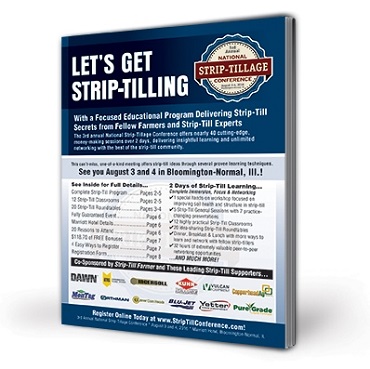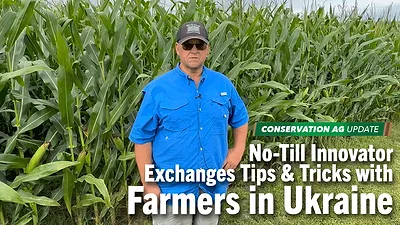BROOKFIELD, Wis. — Building on the success and momentum from its first two events, the 3rd annual National Strip-Tillage Conference will feature nearly 20 in-depth presentations during the course of two education-packed days in early August.
The unique event in Bloomington-Normal, Ill., on Aug. 3 and 4 will bring together a diverse group of top strip-tillers, consultants and researchers who will share experience-based tips and techniques that both veteran and new adopters of strip-till can put to work immediately in their operations.
The just-completed 2016 conference program features 7 general session speakers, 12 classrooms, 20 roundtables and invaluable networking opportunities during a fast-paced 32 hours of in-depth strip-till learning. In addition, registered attendees can sign up for an interactive 3-hour strip-till soil health workshop immediately following the conference with renowned NRCS conservation agronomist Ray Archuleta.
Following is a sample of topics and speakers that will provide growers with a top-notch strip-till experience at the Bloomington-Normal Marriott Hotel this summer:
- Aggressive — but calculated — experimentation with fertility practices and strip-till trials on their 1,200 acre operation in Lakefield, Minn., have helped Jerry Ackermann and his wife, Nancy, decrease input costs and overcome climate challenges to produce corn yields that are commonly 20 bushels per acre above the county average. During the opening general session on Wednesday, Aug. 3 he will break down their motives and methods for trimming the amount of applied nitrogen per bushel of corn to increase production and explain why sometimes, the highest yields aren’t the most economical.
- Get ready to dig deep into the microbial world living within your fields and gain a better understanding of organic growth opportunities from Ray Archuleta, conservation agronomist with the USDA’s Natural Resources Conservation Service. During his interactive post-conference strip-till workshop, Archuleta will take 40 strip-tillers into the field for hands-on demonstrations, explain the benefits of naturally building soil health and illustrate key positive indicators — and warning signs — that strip-tillers should look for to ensure that they’re nurturing their soil for long-term productivity.
- While many farmers collect field data, it’s knowing what to do with the information that will help you improve the productivity and efficiency of your strip-till operation. This is something strip-tiller Trent Sanderson has made a priority to improve management of his family’s 2,000-acre corn, soybean and wheat operation near Clare, Ill. During a general session on Wednesday, Aug. 3, he will reveal how number crunching and analysis of collected data, along with the use of precision farming practices like electric row clutches and rate control, are helping him assess the return on investment of the farm’s strip-till system and shape annual input expenditures.
- Understanding and satisfying early season nutrient needs can help strip-tillers set the stage for a bumper crop, according to USDA Agricultural Research Service (ARS) supervisory plant physiologistJerry Hatfield. During his general session on Thursday, Aug. 4, he will discuss recent research that looks at the correlation between early season nutrient applications on plant health in strip-tilled corn and its impact on yields.
- During a classroom presentation on Thursday, Aug. 4., Woodville, Ont., strip-tiller Dustin Mulock will detail the development and results of his bio strip-till system, to include fertilizer application equipment modifications and experimentation with more than a dozen different cover crop species.
- Recent research shared by Kansas State University soil fertility specialist Dorivar Ruiz Diaz will compare placement of phosphorus in strip-till with other tillage systems to track uptake, carryover and loss. During the dinner general session on Wednesday, Aug. 3, he will share the results of a recently concluded 10-year study on phosphorus application on corn after soybeans in different tillage systems and analyze key takeaways for strip-tillers from the study.
“We've built a diverse program of speakers based on the input of past attendees that really offers the nuts and bolts to help farmers improve their strip-till practices,” says Jack Zemlicka, managing editor of Strip-Till Strategies e-newsletter and StripTillFarmer.com. "The hallway discussions and networking between farmers and educators is invaluable and alone worth the cost of attending."
The 8-page program can be viewed and downloaded here. Early bird registration is available until May 30 at just $224 per person, with a special $204 rate for additional farm or family members.
The event is co-sponsored by Strip-Till Farmer and 12 industry-leading Title Sponsors, including Calmer Corn Heads, Copperhead Ag, Dawn Equipment Co., Environmental Tillage Systems, Ingersoll, Kuhn Krause, Montag Mfg., Orthman Mfg., PureGrade from The Andersons, Thurston Mfg. (Blu-Jet),Vulcan Equipmentand Yetter Mfg. Co.






